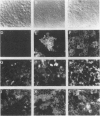Abstract
Self protection of host cells against inadvertent injury resulting from attack by autologous complement proteins is well reported for vascular epithelium. In intestinal epithelium, the expression of C complement proteins and regulatory proteins remains currently poorly reported. This study looked at the distribution of C complement proteins and regulatory decay accelerating factor (DAF) in four cultured human intestinal cell lines of embryogenic or colon cancer origins. C3 and C4 proteins and DAF were widely present in human colon adenocarcinoma T84, HT-29 glc-/+ cells compared with human embryonic INT407 cells. In contrast, no expression of C5, C5b-9, and CR1 was seen for any of the cell lines. Taking advantage of the Caco-2 cells, which spontaneously differentiate in culture, it was seen that the C3, C4, and DAF were present in undifferentiated cells and that their expression increased as a function of the cell differentiation. These results, taken together with other reports on the presence of C complement proteins and DAF in the intestinal cells infer that the expression of regulatory C complement proteins develops in parallel with the expression of C proteins to protect these cells against the potential injury resulting from the activation of these local C proteins. Moreover, the finding that the pathogenic C1845 Escherichia coli binds to the membrane bound DAF in the cultured human intestinal cells synthetising locally C proteins and regulatory C proteins supports the hypothesis that E coli could promote inflammatory disorders by blocking local regulatory protein function.
Full text
PDF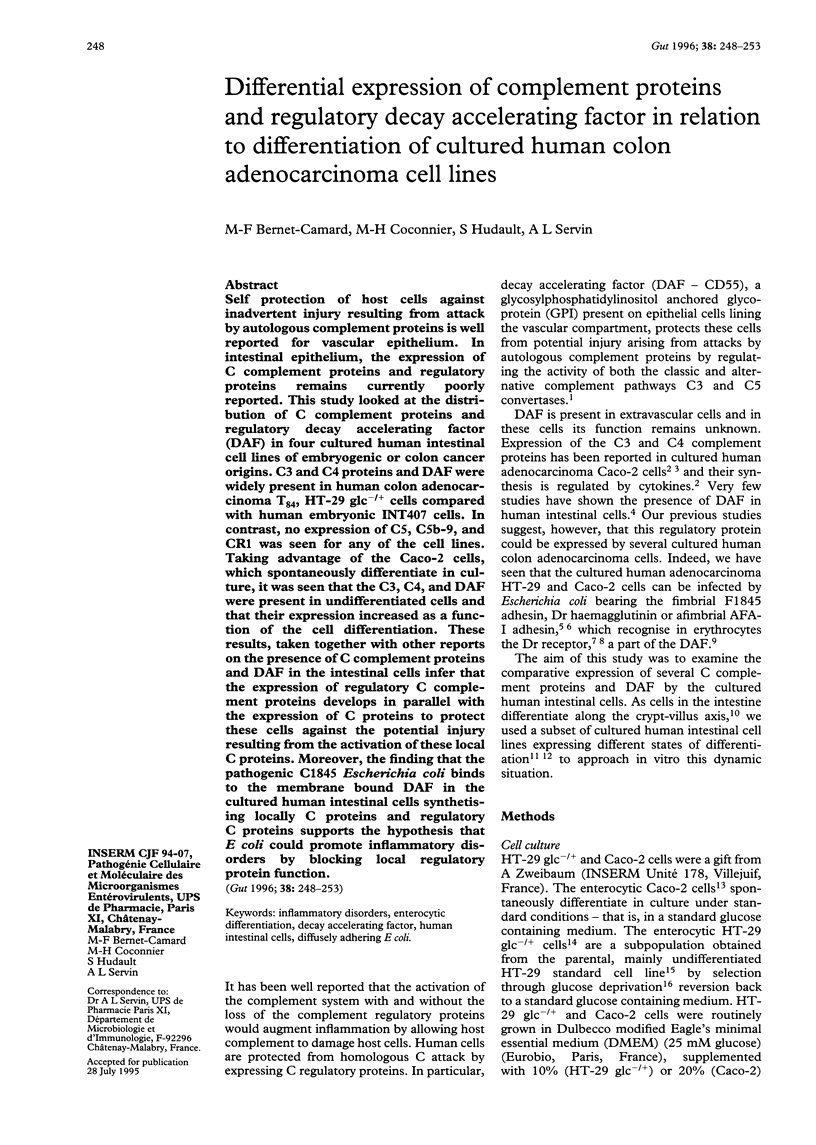
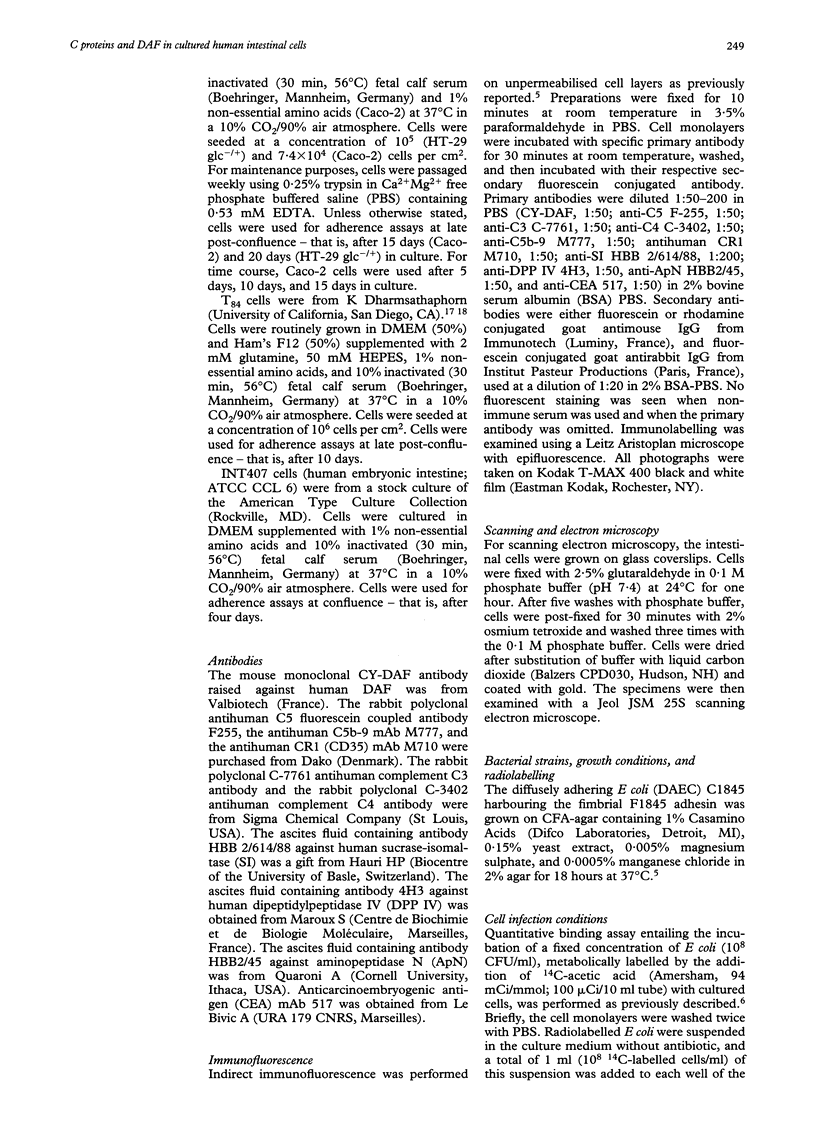
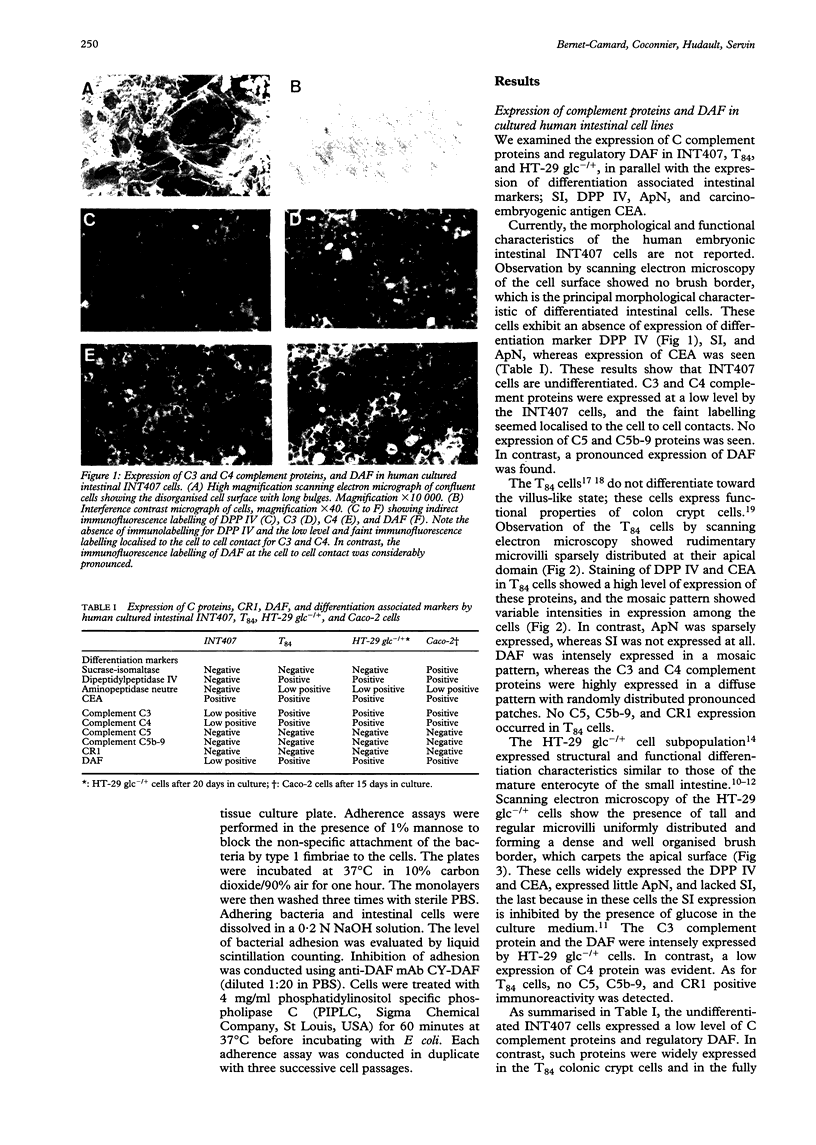
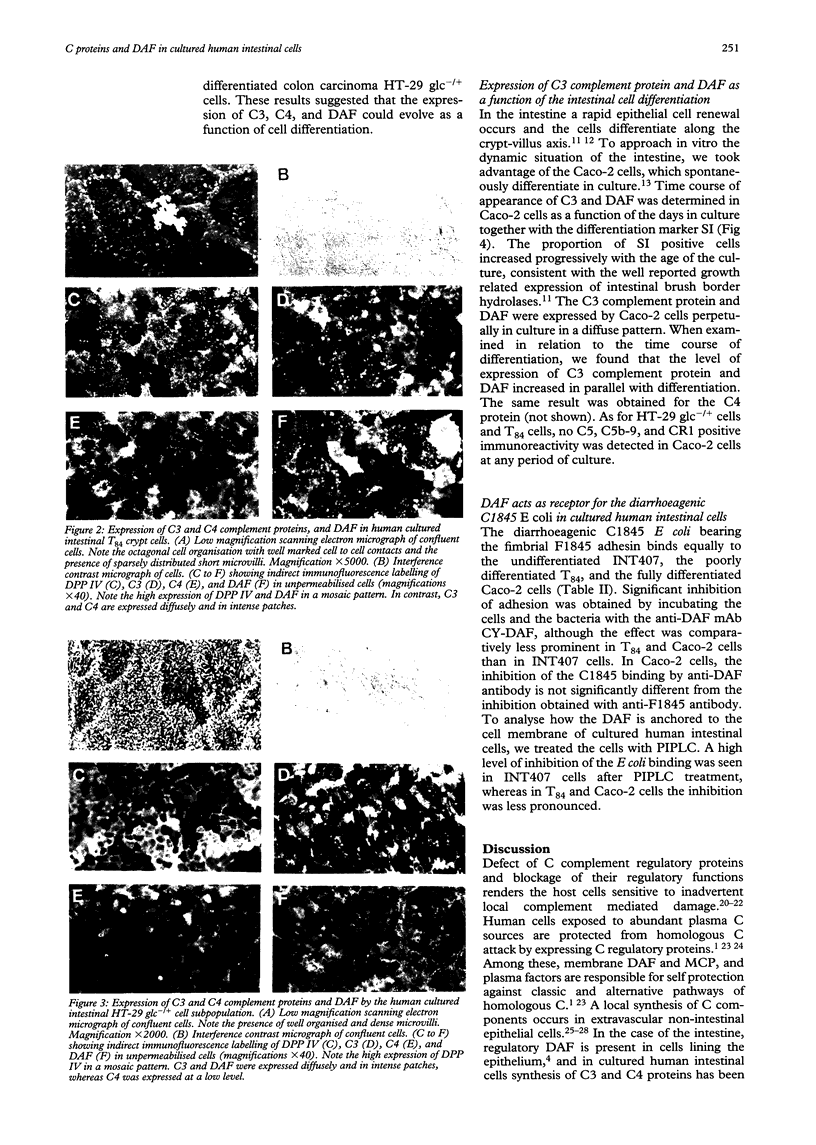

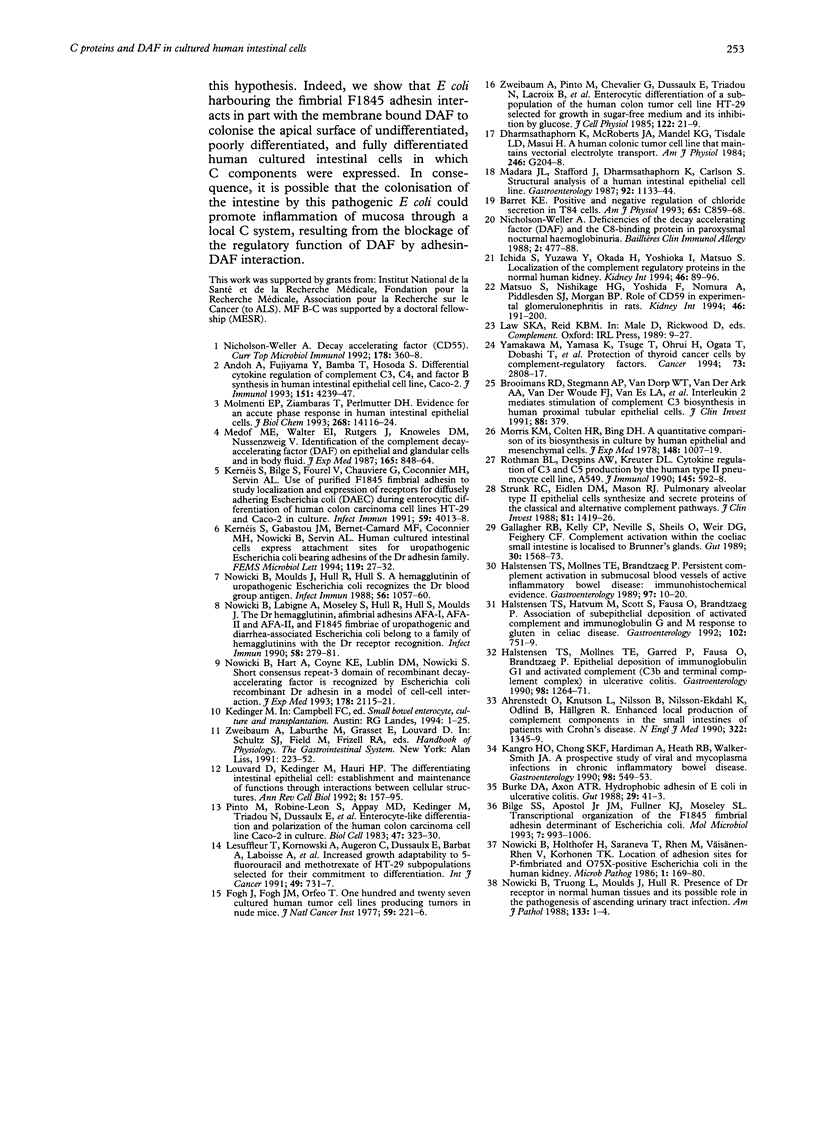
Images in this article
Selected References
These references are in PubMed. This may not be the complete list of references from this article.
- Ahrenstedt O., Knutson L., Nilsson B., Nilsson-Ekdahl K., Odlind B., Hällgren R. Enhanced local production of complement components in the small intestines of patients with Crohn's disease. N Engl J Med. 1990 May 10;322(19):1345–1349. doi: 10.1056/NEJM199005103221903. [DOI] [PubMed] [Google Scholar]
- Andoh A., Fujiyama Y., Bamba T., Hosoda S. Differential cytokine regulation of complement C3, C4, and factor B synthesis in human intestinal epithelial cell line, Caco-2. J Immunol. 1993 Oct 15;151(8):4239–4247. [PubMed] [Google Scholar]
- Barrett K. E. Positive and negative regulation of chloride secretion in T84 cells. Am J Physiol. 1993 Oct;265(4 Pt 1):C859–C868. doi: 10.1152/ajpcell.1993.265.4.C859. [DOI] [PubMed] [Google Scholar]
- Bilge S. S., Apostol J. M., Jr, Fullner K. J., Moseley S. L. Transcriptional organization of the F1845 fimbrial adhesin determinant of Escherichia coli. Mol Microbiol. 1993 Mar;7(6):993–1006. doi: 10.1111/j.1365-2958.1993.tb01191.x. [DOI] [PubMed] [Google Scholar]
- Brooimans R. A., Stegmann A. P., van Dorp W. T., van der Ark A. A., van der Woude F. J., van Es L. A., Daha M. R. Interleukin 2 mediates stimulation of complement C3 biosynthesis in human proximal tubular epithelial cells. J Clin Invest. 1991 Aug;88(2):379–384. doi: 10.1172/JCI115314. [DOI] [PMC free article] [PubMed] [Google Scholar]
- Burke D. A., Axon A. T. Hydrophobic adhesin of E coli in ulcerative colitis. Gut. 1988 Jan;29(1):41–43. doi: 10.1136/gut.29.1.41. [DOI] [PMC free article] [PubMed] [Google Scholar]
- Dharmsathaphorn K., McRoberts J. A., Mandel K. G., Tisdale L. D., Masui H. A human colonic tumor cell line that maintains vectorial electrolyte transport. Am J Physiol. 1984 Feb;246(2 Pt 1):G204–G208. doi: 10.1152/ajpgi.1984.246.2.G204. [DOI] [PubMed] [Google Scholar]
- Fogh J., Fogh J. M., Orfeo T. One hundred and twenty-seven cultured human tumor cell lines producing tumors in nude mice. J Natl Cancer Inst. 1977 Jul;59(1):221–226. doi: 10.1093/jnci/59.1.221. [DOI] [PubMed] [Google Scholar]
- Gallagher R. B., Kelly C. P., Neville S., Sheils O., Weir D. G., Feighery C. F. Complement activation within the coeliac small intestine is localised to Brunner's glands. Gut. 1989 Nov;30(11):1568–1573. doi: 10.1136/gut.30.11.1568. [DOI] [PMC free article] [PubMed] [Google Scholar]
- Halstensen T. S., Hvatum M., Scott H., Fausa O., Brandtzaeg P. Association of subepithelial deposition of activated complement and immunoglobulin G and M response to gluten in celiac disease. Gastroenterology. 1992 Mar;102(3):751–759. doi: 10.1016/0016-5085(92)90155-r. [DOI] [PubMed] [Google Scholar]
- Halstensen T. S., Mollnes T. E., Brandtzaeg P. Persistent complement activation in submucosal blood vessels of active inflammatory bowel disease: immunohistochemical evidence. Gastroenterology. 1989 Jul;97(1):10–19. doi: 10.1016/0016-5085(89)91409-1. [DOI] [PubMed] [Google Scholar]
- Halstensen T. S., Mollnes T. E., Garred P., Fausa O., Brandtzaeg P. Epithelial deposition of immunoglobulin G1 and activated complement (C3b and terminal complement complex) in ulcerative colitis. Gastroenterology. 1990 May;98(5 Pt 1):1264–1271. doi: 10.1016/0016-5085(90)90343-y. [DOI] [PubMed] [Google Scholar]
- Ichida S., Yuzawa Y., Okada H., Yoshioka K., Matsuo S. Localization of the complement regulatory proteins in the normal human kidney. Kidney Int. 1994 Jul;46(1):89–96. doi: 10.1038/ki.1994.247. [DOI] [PubMed] [Google Scholar]
- Kangro H. O., Chong S. K., Hardiman A., Heath R. B., Walker-Smith J. A. A prospective study of viral and mycoplasma infections in chronic inflammatory bowel disease. Gastroenterology. 1990 Mar;98(3):549–553. doi: 10.1016/0016-5085(90)90272-3. [DOI] [PubMed] [Google Scholar]
- Kerneis S., Bilge S. S., Fourel V., Chauviere G., Coconnier M. H., Servin A. L. Use of purified F1845 fimbrial adhesin to study localization and expression of receptors for diffusely adhering Escherichia coli during enterocytic differentiation of human colon carcinoma cell lines HT-29 and Caco-2 in culture. Infect Immun. 1991 Nov;59(11):4013–4018. doi: 10.1128/iai.59.11.4013-4018.1991. [DOI] [PMC free article] [PubMed] [Google Scholar]
- Kernéis S., Gabastou J. M., Bernet-Camard M. F., Coconnier M. H., Nowicki B. J., Servin A. L. Human cultured intestinal cells express attachment sites for uropathogenic Escherichia coli bearing adhesins of the Dr adhesin family. FEMS Microbiol Lett. 1994 Jun 1;119(1-2):27–32. doi: 10.1111/j.1574-6968.1994.tb06862.x. [DOI] [PubMed] [Google Scholar]
- Lesuffleur T., Kornowski A., Augeron C., Dussaulx E., Barbat A., Laboisse C., Zweibaum A. Increased growth adaptability to 5-fluorouracil and methotrexate of HT-29 sub-populations selected for their commitment to differentiation. Int J Cancer. 1991 Nov 11;49(5):731–737. doi: 10.1002/ijc.2910490517. [DOI] [PubMed] [Google Scholar]
- Louvard D., Kedinger M., Hauri H. P. The differentiating intestinal epithelial cell: establishment and maintenance of functions through interactions between cellular structures. Annu Rev Cell Biol. 1992;8:157–195. doi: 10.1146/annurev.cb.08.110192.001105. [DOI] [PubMed] [Google Scholar]
- Madara J. L., Stafford J., Dharmsathaphorn K., Carlson S. Structural analysis of a human intestinal epithelial cell line. Gastroenterology. 1987 May;92(5 Pt 1):1133–1145. doi: 10.1016/s0016-5085(87)91069-9. [DOI] [PubMed] [Google Scholar]
- Matsuo S., Nishikage H., Yoshida F., Nomura A., Piddlesden S. J., Morgan B. P. Role of CD59 in experimental glomerulonephritis in rats. Kidney Int. 1994 Jul;46(1):191–200. doi: 10.1038/ki.1994.259. [DOI] [PubMed] [Google Scholar]
- Medof M. E., Walter E. I., Rutgers J. L., Knowles D. M., Nussenzweig V. Identification of the complement decay-accelerating factor (DAF) on epithelium and glandular cells and in body fluids. J Exp Med. 1987 Mar 1;165(3):848–864. doi: 10.1084/jem.165.3.848. [DOI] [PMC free article] [PubMed] [Google Scholar]
- Molmenti E. P., Ziambaras T., Perlmutter D. H. Evidence for an acute phase response in human intestinal epithelial cells. J Biol Chem. 1993 Jul 5;268(19):14116–14124. [PubMed] [Google Scholar]
- Morris K. M., Colten H. R., Bing D. H. The first component of complement. A quantitative comparison of its biosynthesis in culture by human epithelial and mesenchymal cells. J Exp Med. 1978 Oct 1;148(4):1007–1019. doi: 10.1084/jem.148.4.1007. [DOI] [PMC free article] [PubMed] [Google Scholar]
- Nowicki B., Hart A., Coyne K. E., Lublin D. M., Nowicki S. Short consensus repeat-3 domain of recombinant decay-accelerating factor is recognized by Escherichia coli recombinant Dr adhesin in a model of a cell-cell interaction. J Exp Med. 1993 Dec 1;178(6):2115–2121. doi: 10.1084/jem.178.6.2115. [DOI] [PMC free article] [PubMed] [Google Scholar]
- Nowicki B., Holthöfer H., Saraneva T., Rhen M., Väisänen-Rhen V., Korhonen T. K. Location of adhesion sites for P-fimbriated and for 075X-positive Escherichia coli in the human kidney. Microb Pathog. 1986 Apr;1(2):169–180. doi: 10.1016/0882-4010(86)90019-7. [DOI] [PubMed] [Google Scholar]
- Nowicki B., Labigne A., Moseley S., Hull R., Hull S., Moulds J. The Dr hemagglutinin, afimbrial adhesins AFA-I and AFA-III, and F1845 fimbriae of uropathogenic and diarrhea-associated Escherichia coli belong to a family of hemagglutinins with Dr receptor recognition. Infect Immun. 1990 Jan;58(1):279–281. doi: 10.1128/iai.58.1.279-281.1990. [DOI] [PMC free article] [PubMed] [Google Scholar]
- Nowicki B., Moulds J., Hull R., Hull S. A hemagglutinin of uropathogenic Escherichia coli recognizes the Dr blood group antigen. Infect Immun. 1988 May;56(5):1057–1060. doi: 10.1128/iai.56.5.1057-1060.1988. [DOI] [PMC free article] [PubMed] [Google Scholar]
- Nowicki B., Truong L., Moulds J., Hull R. Presence of the Dr receptor in normal human tissues and its possible role in the pathogenesis of ascending urinary tract infection. Am J Pathol. 1988 Oct;133(1):1–4. [PMC free article] [PubMed] [Google Scholar]
- Oxford J. S., Coates A. R., Sia D. Y., Brown K., Asad S. Potential target sites for antiviral inhibitors of human immunodeficiency virus (HIV). J Antimicrob Chemother. 1989 Jan;23 (Suppl A):9–27. doi: 10.1093/jac/23.suppl_a.9. [DOI] [PubMed] [Google Scholar]
- Rothman B. L., Despins A. W., Kreutzer D. L. Cytokine regulation of C3 and C5 production by the human type II pneumocyte cell line, A549. J Immunol. 1990 Jul 15;145(2):592–598. [PubMed] [Google Scholar]
- Strunk R. C., Eidlen D. M., Mason R. J. Pulmonary alveolar type II epithelial cells synthesize and secrete proteins of the classical and alternative complement pathways. J Clin Invest. 1988 May;81(5):1419–1426. doi: 10.1172/JCI113472. [DOI] [PMC free article] [PubMed] [Google Scholar]
- Yamakawa M., Yamada K., Tsuge T., Ohrui H., Ogata T., Dobashi M., Imai Y. Protection of thyroid cancer cells by complement-regulatory factors. Cancer. 1994 Jun 1;73(11):2808–2817. doi: 10.1002/1097-0142(19940601)73:11<2808::aid-cncr2820731125>3.0.co;2-p. [DOI] [PubMed] [Google Scholar]
- Zweibaum A., Pinto M., Chevalier G., Dussaulx E., Triadou N., Lacroix B., Haffen K., Brun J. L., Rousset M. Enterocytic differentiation of a subpopulation of the human colon tumor cell line HT-29 selected for growth in sugar-free medium and its inhibition by glucose. J Cell Physiol. 1985 Jan;122(1):21–29. doi: 10.1002/jcp.1041220105. [DOI] [PubMed] [Google Scholar]






